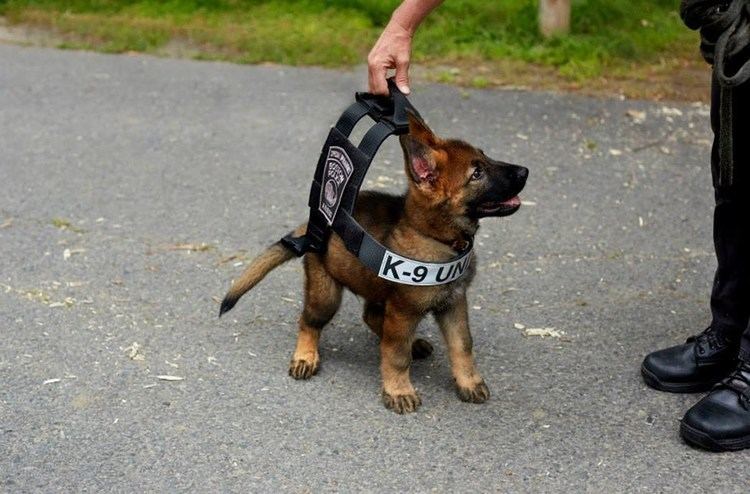 | ||
Mass German Shepherd: 30 – 40 kg Representative species | ||
Pet a k 9 police dog emergency fest 2015
A police dog, known in some English-speaking countries as a "K-9" or "K9" (a homophone of "canine"), is a dog that is specifically trained to assist police and other law-enforcement personnel in their work. Their duties include searching for drugs and explosives, searching for lost people, looking for crime scene evidence, and protecting their handlers. Police dogs must remember several hand and verbal commands. The most commonly used breed is the German Shepherd.
Contents
- Pet a k 9 police dog emergency fest 2015
- Early history
- Modern era
- Specialized police dogs
- Popular breeds
- Retirement
- Australia
- Belgium
- Canada
- Denmark
- Hong Kong
- Netherlands
- India
- Russia
- Sweden
- United Kingdom
- United States
- References

In many common law jurisdictions, the intentional injuring or killing of a police dog is a felony.
Early history

Dogs have been used for law enforcement since at least the Middle Ages. Money was then set aside in the villages for the upkeep of the parish constable's bloodhounds that were used for hunting down outlaws. In France, dogs were used in the 14th century in St. Malo. Bloodhounds used in Scotland were known as "Slough dogs" - the word "Sleuth", (meaning detective) was derived from this.
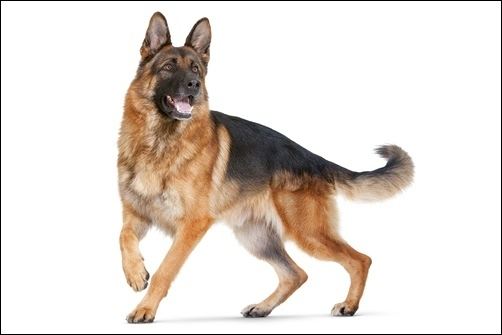
The rapid urbanization of London in the 19th century increased public concern regarding growing lawlessness - a problem that was far too great to be dealt with by the existing law enforcement of the time. As a result, private associations were formed to help combat crime. Night watchmen were employed to guard premises with many of these individuals provided with firearms and dogs to protect themselves from the criminal elements.
Modern era
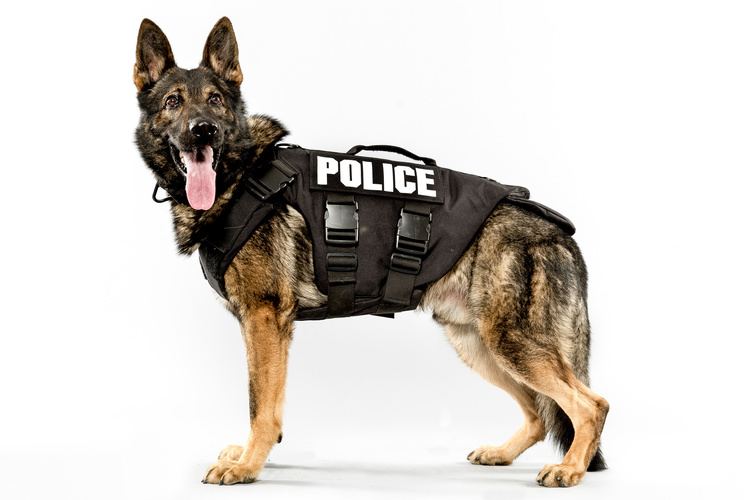
One of the first real attempts to use dogs to aid police in the detection of crime and the apprehension of a criminal was made in 1869 by the Commissioner of the Metropolitan Police of London, Sir Charles Warren. Warren's repeated failures at identifying and apprehending the serial killer Jack the Ripper had earned him much vilification from the press, including being denounced for not using bloodhounds to track the killer. He soon had two bloodhounds trained for the performance of a simple tracking test from the scene of another of the killer's crimes. The results were far from satisfactory, with one of the hounds biting the Commissioner and both dogs later running off, requiring a police search to find them.
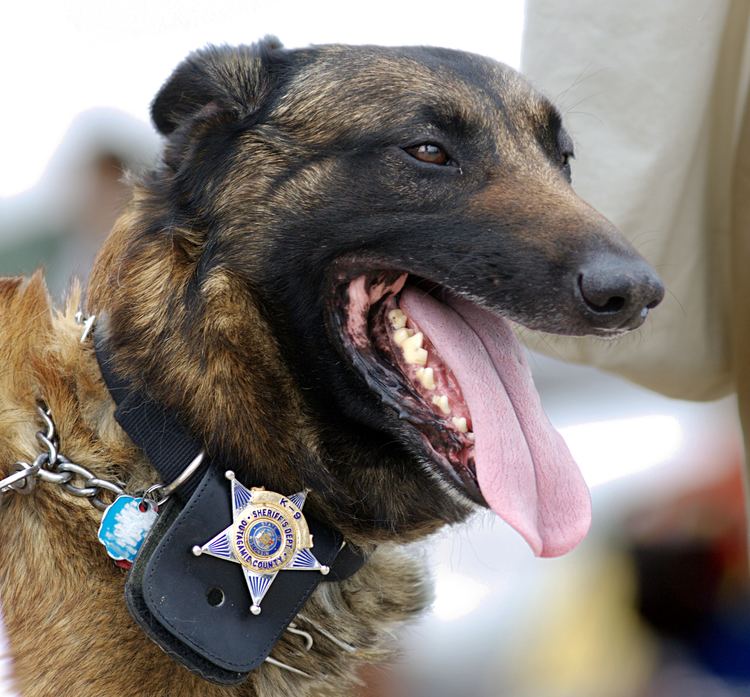
It was in Continental Europe that dogs were first used on a large scale. Police in Paris began using dogs against roaming criminal gangs at night, but it was the police department in Ghent, Belgium that introduced the first organized police dog service program in 1899. These methods soon spread to Austria-Hungary and Germany; in the latter the first scientific developments in the field took place with experiments in dog breeding and training. The German police selected the German Shepherd Dog as the ideal breed for police work and opened up the first dog training school in 1920 in Greenheide. The dogs were systematically trained in obedience to their officers and tracking and attacking criminals.
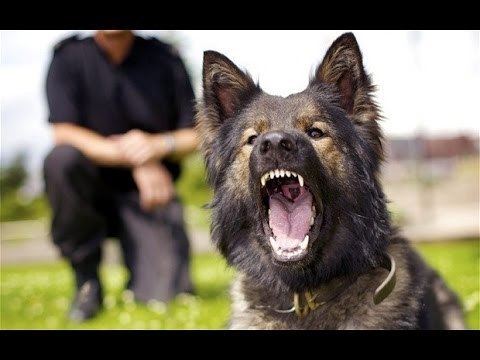
In Britain, the North Eastern Railway Police were the first to use police dogs in 1908 to put a stop to theft from the docks in Hull. By 1910, railway police forces were experimenting with other breeds such as Labrador Retrievers, Doberman Pinschers, and German Shepherds.
Specialized police dogs
Popular breeds
Some breeds are used to enforce public order by chasing and holding suspects, or detaining suspects by the threat of being released, either by direct apprehension or a method known as Bark and Hold. Police dogs, such as the German Shepherd breed, have many qualities that make them applicable for the job. A successful police dog should be intelligent, aggressive, strong, and have a good sense of smell. Many police dogs that are chosen are male and remain unneutered to maintain their aggressive behavior, however there are female police dogs which are used for rescue, tracking, and locating bombs and drugs. German Shepherd dogs and Belgian Malinois are most commonly used because of their availability; however other dog breeds have also contributed, such as Dutch Shepherds, Rottweilers, Boxers, Doberman Pinschers, Bouvier des Flandres, Giant Schnauzers, and Airedale Terriers.
Notable police dog breeds are:
Retirement
Police dogs are retired if they become injured to an extent where they will not recover completely, pregnant, or raising puppies, or are too old or sick to continue working. Since many dogs are raised in working environments for the first year of their life and retired before they become unable to perform, the working life of a dog is 6–9 years.
If these dogs are killed in the line of duty they get the same honors as their human partners. The handler makes all the decisions regarding their partner.
Australia
The Australian Federal Police and other law enforcement agencies are known to employ K9 dogs for security priorities such as airport duties.
Belgium
The Belgian Canine Support Group is part of the country's federal police. It has 35 dog teams. Some dogs are trained to detect drugs, human remains, hormones or fire accelerants. About a third are tracker dogs trained to find or identify living people. These teams are often deployed to earthquake areas to locate people trapped in collapsed buildings. The federal police's explosive detector dogs are attached to the Federal Police Special Units.
Canada
Many Canadian municipalities use dog squads as a means of tracking suspects. Most municipalities in Canada employ the bite and hold technique rather than the bark and hold technique meaning once the dog is deployed, it bites the suspect until the dog handler commands it to release. This often results in serious puncture wounds and is traumatic for suspects. A dog has the legal status of property in Canada. As such, developing case law is moving towards absolute liability for the handlers of animals deliberately released to intentionally maim suspects. The dog is, effectively, a weapon.
In 2010, an Alberta Court of Queen's Bench judge stayed criminal charges against Kirk Steele, a man who was near-fatally shot by a police officer while he stabbed the officer's police dog. The judge found that the shooting was cruel and unusual treatment and excessive force.
Police require reasonable suspicion they will recover evidence in order to use a dog to sniff a person or their possessions in public. This is because using a dog to detect scents is considered a search. The main exemption to that rule are the dogs of the Canada Border Services Agency who are allowed to make searches without warrants under s.98 of the Customs Act.
Denmark
There are a total of 240 active police dogs in Denmark. They are ranked in three groups: Group-1, Group-2, Group-3. Group-1: is for the very experienced, and highly trained dogs. Typical in the age of 4–8 years old. These dogs are used for: Patrolling, Search and Rescue, biological evidence searching and major crimes investigations. Group-2 dogs is used for the same as Group-1 dogs except for major crimes investigations and biological evidence searching. Group-3 dogs is the first rank. and the dogs are only used for patrolling. The Danish police have used police dogs since 1907. the only approved dog is a German Shepherd. There are only male dogs in the police. The dog patrolling cars are only station cars.
Hong Kong
The Police Dog Unit, (Abbreviation: PDU; Chinese: 警犬隊) established in 1949, is a specialist force of the Hong Kong Police under the direct command of the Special Operations Bureau. Its role is in crowd control, search and rescue and poison and explosive detection. In addition, the Police Dog Unit works in collaboration with other departments for anti-crime operations.
Netherlands
The Dutch Mounted Police and Police Dog Service (DLHP) is part of the Korps landelijke politiediensten (KLPD; National Police Services Agency) and supports other units with horse patrols and specially trained dogs. The DLHP's dogs are trained to recognize a single specific scent. They specialize in identifying scents (identifying the scent shared by an object and a person), narcotics, explosives and firearms, detecting human remains, locating drowning people and fire accelerants.
The KLPD is just one of the 26 police regions in the Netherlands. Every other region has its own K-9 unit. For example, the K-9 unit of the regional police Amsterdam-Amstelland has 24 patroldog handlers and 6 specialdog handlers and 4 instructors. The unit has 24 patroldogs, 3 explosives/firearms dogs, 3 active narcotic dogs, 2 passive narcotic dogs,2 scent identifying dogs, 1 crime scene dog and 1 USAR dog. They work on a 24/7 basis, every shift (07:00-15:00/15:00-23:00/23:00-07:00 local time), has a minimum of 2 patroldog handlers on patrol. The special dog handlers work only in the dayshift or after a call.
India
In India, the National Security Guard inducted Malinois (Belgian Shepherd Dog) into its K-9 Unit, Border Security Force and Central Reserve Police Force use Rajapalayam as guard dogs to support the Force in the borders of Kashmir. Most of the Indian State Local Police use Labrador Retriever, German Shepherd and Doberman Pinscher in their Dog Squads. The Delhi Police has recruited many of the city's street dogs to be trained for security purposes.
Russia
Police on patrol have often used attack dogs, generally East European Shepherds or large German Shepherd Dogs bred to weigh at least 35 kilograms (77 lbs.) These are kept on a leash at all times and required to wear muzzles, removed only when needed to pursue and detain suspects. They are trained to remain calm, docile, and unfazed by crowds and noise. Such dogs will react to stimuli only if ordered to do so. They are a common sight in cities and are rarely if ever perceived as unnerving by the general public.
Crime scene investigation units and patrols seeking dangerous fugitives have also been known to use dogs for tracking. These units also use German Shepherd Dogs - a breed that was chosen as the all-purpose police and army breed. These practices have remained common in most of the Soviet Union's successor states.
Sweden
The Swedish law enforcement acquired its first two dogs in 1910, when two police officers brought Airedale Terrier Cora and shepherd Leo from Hamburg to assist in police investigations, but regular use of K9 did not take off until the 1950s. The Swedish Police Authority currently deploys around 400 police dogs, of which about 70 percent German Shepherds and 20 percent Malinois. The remaining 10 percent consist of a range of breeds, including Boxers, Labradors, and Springer Spaniel. There is however no requirement for the dogs to be purebred, as long as they meet mental and physical requirements set by the police. Dogs aged 18–48 months are eligible to take admission tests for the K9 training. The police dogs live with their operators, and after retirement at age 8-10 the operator often assumes the ownership of the dog.
United Kingdom
Police forces across the country employ dogs and handlers and dog training schools are available to cater for the ever increasing number of dogs being used.
There are over 2,500 police dogs employed amongst the various police forces in the UK, with the German Shepherd as the most popular breed for general purpose work. The Belgian Malinois is also gaining in popularity; in 2008, a Belgian Malinois female handled by PC Graham Clarke won the National Police Dog Trials with the highest score ever recorded.
All British police dogs, irrespective of the discipline they are trained in, must be licensed to work operationally. To obtain the license they have to pass a test at the completion of their training, and then again every year until they retire, which is usually at about the age of 8. The standards required to become operational are laid down by the Association of Chief Police Officers (ACPO) sub-committee on police dogs and are reviewed on a regular basis to ensure that training and licensing reflects the most appropriate methods and standards.
Many British police services now source the majority of their replacement dogs from within specialized police dog breeding programs designed to ensure that the dogs are bred with strong working ethics and health as a priority. The Metropolitan Police has the largest police dog breeding program in the UK supplying not only the capital city, London, but many other parts of the UK and the world with police service dogs.
In 2011, a freedom of information request by British broadcaster BBC to all 48 police forces in the UK revealed that between 2008–2010 196 police staff and 155 innocent members of the public were bitten by police dogs. A similar investigation in 2014 revealed that between 2011–2013 police dogs were involved in at least 150 attacks on innocent members of the public including two 10-year-old children.
United States
Police dogs are in widespread use across the United States. K-9 units are operated on the federal, state, county, and local level and are utilized for a wide variety of duties, similar to those of other nations. Their duties generally include drug, bomb, and weapon detection and cadaver searches. The most common police dogs used for everyday duties are German Shepherds, though other breeds may be used to perform specific tasks.
On the federal level, police dogs are rarely seen by the general public, though they may be viewed in some airports assisting Transportation Security Administration officials search for explosives and weapons or by Customs and Border Protection searching for concealed narcotics and people. Some dogs may also be used by tactical components of such agencies as the Bureau of Alcohol, Tobacco, Firearms, and Explosives, the Federal Bureau of Investigation, and the United States Marshals Service.
Most police agencies in the United States - whether state, county, or local – use K-9s as a means of law enforcement. Often, even the smallest of departments operates a K-9 team of at least one dog, while the officers of more metropolitan cities can be more used to working with dozens. In the former case, police dogs usually serve all purposes deemed necessary, most commonly suspect apprehension and narcotics detection, and teams are often on call; in the latter case, however, individual dogs usually serve individual purposes in which each particular animal is specialized, and teams usually serve scheduled shifts. In both cases, police dogs are almost always cared for by their specific handlers. K-9s are not often seen by the public, though specialized police vehicles used for carrying dogs may be seen from time to time.
It is a felony to assault or kill a federal law enforcement animal, and it is a crime in most states to assault or kill a police animal. Yet despite common belief, police dogs are not treated as police officers for the purpose of the law, and attacking a police dog is not punishable in the same manner as attacking a police officer. Though many police departments formally swear dogs in as police officers, this swearing-in is purely honorary, and carries no legal significance.
Police dogs also play a major role in American penal systems. Many jails and prisons will use special dog teams as a means of intervening in large-scale fights or riots by inmates. Also, many penal systems will employ dogs – usually bloodhounds – in searching for escaped prisoners.
